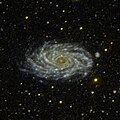NGC 2336
| Apparent magnitude (V) | 10.3 |
|---|---|
| Characteristics | |
| Type | SAB(r)bc [1] |
| Apparent size (V) | 7.1′ × 3.9′[1] |
| Other designations | |
| UGC 3809, MCG +13-06-006, PGC 21033[1] | |
NGC 2336 is a
Characteristics
NGC 2336 is a
In the large arms of the galaxy have been observed 28 HII regions that may host young massive star clusters, and for two of them the nebular emission comprises most of the flux. Three of these HII areas have ages calculated to be 100 to 300 million years and have sizes between 300 and 600 parsecs. It is suggested they are star complexes that may coexist with younger ones. The most massive of the HII regions, number 13, has a mass estimated to be (550±169)×104 M☉ and is 2,600 ly (810 pc) across.[6] Observations in the ultraviolet showed 78 star forming regions, with two of them between the spiral arms and six at the galaxy ring. Their size is comparable to NGC 604, one of the largest nebulae in the Local Group. Star formation is more intense in the inner parts of the arms and at the ring.[7]
Scattered
Supernova
One
Nearby galaxies
NGC 2336 is the foremost galaxy of a small galaxy group known as the NGC 2336 group.[15] It forms a non-interacting pair with IC 467, which lies 20 arcminutes away.[16]
Gallery
-
NGC 2336 by the Mount Lemmon Observatory
-
NGC 2336 by GALEX
-
NGC 2336 by the HST
-
NGC 2336 is the quintessential galaxy — big, beautiful and blue — and it is captured here by the NASA/ESA Hubble Space Telescope.
-
NGC 2336 by the Naval Observatory 61" Reflector
-
NGC 2336 and SN 1987L, August 26, 1987 - by Jack Newton
References
- ^ a b c d e f g h "NASA/IPAC Extragalactic Database". Results for NGC 2336. Retrieved 2016-01-18.
- ^ Seligman, Courtney. "NGC 2336". Celestial Atlas. Retrieved 19 November 2018.
- ^ S2CID 14749261.
- ^ Sandage, A., Bedke, J. (1994), The Carnegie Atlas of Galaxies. Volume I, Carnegie Institution of Washington, p. 15
- ^ .
- S2CID 118736701.
- S2CID 118843858.
- S2CID 15161097.
- .
- S2CID 17630682.
- ^ Astronomy Magazine, June 1988, pg. 62-63
- ^ "IAUC 4441: 1987L; 1987u; 1987 OA". www.cbat.eps.harvard.edu. Retrieved 2021-04-07.
- ^ "Biographies". www.physics.purdue.edu. Retrieved 2021-04-08.
- S2CID 121470638.
- S2CID 119194025. Archived from the originalon 31 January 2016. Retrieved 26 November 2018.
- Bibcode:1976RC2...C......0D.
External links
- NGC 2336 on







